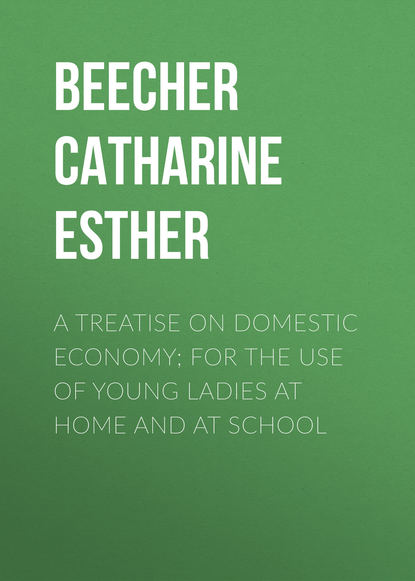 Полная версия
Полная версияA Treatise on Domestic Economy; For the Use of Young Ladies at Home and at School
It will be wise for those parents, who find little time to attend to their children, or to seek amusement and enjoyment in the domestic and social circle, because their time is so much occupied with public cares or benevolent objects, to inquire, whether their first duty is not to train up their own families, to be useful members of society. A man, who neglects the mind and morals of his children, to take care of the public, is in great danger of coming under a similar condemnation, to that of him, who, neglecting to provide for his own household, has "denied the faith, and is worse than an infidel."
There are husbands and fathers, who conscientiously subtract time from their business, to spend at home, in reading with their wives and children, and in domestic amusements which at once refresh and improve. The children of such parents will grow up with a love of home and kindred, which will be the greatest safeguard against future temptations, as well as the purest source of earthly enjoyment.
There are families, also, who make it a definite object to keep up family attachments, after the children are scattered abroad; and, in some cases, secure the means for doing this, by saving money, which would otherwise have been spent for superfluities of food or dress. Some families have adopted, for this end, a practice, which if widely imitated, would be productive of extensive benefit. The method is this. On the first day of each month, some member of the family, at each extreme point of dispersion, takes a folio sheet, and fills a part of a page. This is sealed and mailed to the next family, who read it, add another contribution, and then mail it to the next. Thus the family circular, once a month, goes from each extreme, to all the members of a widely-dispersed family, and each member becomes a sharer in the joys, sorrows, plans, and pursuits, of all the rest. At the same time, frequent family meetings are sought; and the expense, thus incurred, is cheerfully met by retrenchments in other directions. The sacrifice of some unnecessary physical indulgence, (such, for instance, as the use of tea and coffee,) will often purchase many social and domestic enjoyments, a thousand times more elevating and delightful, than the retrenched luxury.
There is no social duty, which the Supreme Lawgiver more strenuously urges, than hospitality and kindness to strangers, who are classed with the widow and the fatherless, as the special objects of Divine tenderness. There are some reasons, why this duty peculiarly demands attention from the American people.
Reverses of fortune, in this land, are so frequent and unexpected, and the habits of the people are so migratory, that there are very many in every part of the Country, who, having seen all their temporal plans and hopes crushed, are now pining among strangers, bereft of wonted comforts, without friends, and without the sympathy and society, so needful to wounded spirits. Such, too frequently, sojourn long and lonely, with no comforter but Him who "knoweth the heart of a stranger."
Whenever, therefore, new comers enter a community, inquiry should immediately be made, whether they have friends and associates, to render sympathy and kind attentions; and, when there is any need for it, the ministries of kind neighborhood should immediately be offered. And it should be remembered, that the first days of a stranger's sojourn, are the most dreary, and that civility and kindness are doubled in value, by being offered at an early period.
In social gatherings, the claims of the stranger are too apt to be forgotten; especially, in cases where there are no peculiar attractions of personal appearance, or talents, or high standing. Such a one should be treated with attention, because he is a stranger; and when communities learn to act more from principle, and less from selfish impulse, on this subject, the sacred claims of the stranger will be less frequently forgotten.
The most agreeable hospitality, to visiters, who become inmates of a family, is, that which puts them entirely at ease. This can never be the case, where the guest perceives that the order of family arrangements is essentially altered, and that time, comfort, and convenience are sacrificed, for his accommodation.
Offering the best to visiters, showing a polite regard to every wish expressed, and giving precedence to them, in all matters of comfort and convenience, can be easily combined with the easy freedom which makes the stranger feel at home; and this is the perfection of hospitable entertainment.
CHAPTER XXIV.
ON THE CONSTRUCTION OF HOUSES
There is no point of domestic economy, which more seriously involves the health and daily comfort of American women, than the proper construction of houses. There are five particulars, to which attention should be given, in building a house; namely, economy of labor, economy of money, economy of health, economy of comfort, and good taste. Some particulars will here be pointed out, under each of these heads.
The first, respects economy of labor. In deciding upon the size and style of a house, the health and capacity of the housekeeper, and the probabilities of securing proper domestics, ought to be the very first consideration. If a man be uncertain as to his means for hiring service, or if he have a feeble wife, and be where properly-qualified domestics are scarce, it is very poor economy to build a large house, or to live in a style which demands much labor. Every room in a house adds to the expense involved in finishing and furnishing it, and to the amount of labor spent in sweeping, dusting, cleaning floors, paint, and windows, and taking care of, and repairing, its furniture. Double the size of a house, and you double the labor of taking care of it, and so, vice versa. There is, in this Country, a very great want of calculation and economy, in this matter.
The arrangement of rooms, and the proper supply of conveniences, are other points, in which, economy of labor and comfort is often disregarded. For example, a kitchen will be in one story, a sitting-room in another, and the nursery in a third. Nothing is more injurious, to a feeble woman, than going up and down stairs; and yet, in order to gain two large parlors, to show to a few friends, or to strangers, immense sacrifices of health, comfort, and money, are made. If it be possible, the nursery, sitting-parlor, and kitchen, ought always to be on the same floor.
The position of wells and cisterns, and the modes of raising and carrying water, are other particulars, in which, economy of labor and comfort is sadly neglected. With half the expense usually devoted to a sideboard or sofa, the water used from a well or cistern can be so conducted, as that, by simply turning a cock, it will flow to the place where it is to be used.
A want of economy, in labor and in money, is often seen in the shape and arrangement of houses, and in the style of ornaments and furniture. A perfect square, encloses more rooms, at less expense, than any other shape; while it has less surface exposed to external cold, and can be most easily warmed and ventilated. And the farther a house is removed from this shape, the more the expense is increased. Wings and kitchens built out, beyond a house, very much increase expense, both in building and warming them.
Piazzas and porticoes are very expensive; and their cost would secure far more comfort, if devoted to additional nursery or kitchen conveniences. Many kinds of porticoes cost as much as one additional room in the house. Houses can be so constructed, that one staircase will answer for both kitchen and parlour use, as may be seen in the engraving on page 269, (Fig. 27.) This saves the expense and labor usually devoted to a large hall and front staircase.
Much money is often worse than wasted, by finical ornaments, which are fast going out of fashion. One of the largest, most beautiful, and agreeable, houses, the writer was ever in, was finished with doors, windows, and fireplaces, in even a plainer style than any given in the subsequent drawings.
The position of fireplaces has much to do with economy of expense in warming a house. Where the fireplace is in an outer wall, one third of the heat passes out of doors, which would be retained in the house, if the chimney were within the rooms. A house, contrived like the one represented in the engraving on page 272, (Fig. 32,) which can be heated by a stove or chimney at X, may be warmed with less fuel than one of any other construction.18
Economy of health is often disregarded, by placing wells, cisterns, and privies, so that persons, in the perspiration of labor, or the debility of disease, are obliged to go out of doors in all weathers. Figure 35, on page 276, shows the proper arrangement of such conveniences. The placing of an outside door, for common use, in a sitting-room, as is frequent at the West and South, is detrimental to health. In such cases, children, in their sports, or persons who labor, are thrown into perspiration, by exercise, the door is thrown open, a chill ensues, and fever, bowel complaints, or bilious attacks, are the result. A long window, extending down to the floor, which can be used as a door, in Summer, and be tightly closed, at the bottom, in Winter, secures all the benefits, without the evils, of an outside door.
Constructing houses, without open fireplaces in chambers, or any other mode of ventilation, is another sad violation of the economy of health. Feeble constitutions in children, and ill health to domestics, are often caused by this folly.
The economy of comfort is often violated, by arrangements made for domestics. Many a woman has been left to endure much hard labor and perplexity, because she chose to have money spent on handsome parlors and chambers, for company, which should have been devoted to providing a comfortable kitchen and chambers for domestics. Cramping the conveniences and comfort of a family, in order to secure elegant rooms, to show to company, is a weakness and folly, which it is hoped will every year become less common.
The construction of houses with reference to good taste, is a desirable, though less important, item. The beauty of a house depends very much upon propriety of proportions, color, and ornament. And it is always as cheap, and generally cheaper, to build a house in agreement with the rules of good taste, than to build an awkward and ill-proportioned one.
Plans of Houses and Domestic ConveniencesThe following plans are designed chiefly for persons in moderate circumstances, and have especial reference to young housekeepers.
Every year, as the prosperity of this Nation increases, good domestics will decrease, and young mothers are hereafter to be called to superintend and perform all branches of domestic business, to nurse children, direct ignorant domestics, attend the sick, entertain company, and fulfil all other family duties; and this, too, in a majority of cases, with delicate constitutions, or impaired health. Every man, therefore, in forming plans for a future residence, and every woman who has any influence in deciding such matters, ought to make these probabilities the chief basis of their calculations.19
Fig. 17.

Fig. 18.
Ground-plan.

Scale of Feet.
a, Porch.
b, Parlor, 15 by 16 feet.
c, Dining-room, 15 by 16 feet.
d, d, Small Bedrooms.
e, Stairs.
f, f, f, Closets.
g, Pantry.
h, Store-closet.
i, i, i, Fireplaces.
j, Kitchen.
k, Bedpress.
z, Cellar door.
The plan, exhibited in Figures 17, and 18, is that of a cottage, whose chief exterior beauty is its fine proportions. It should be painted white.
Fig. 17, is the elevation, or the front view of the exterior. Fig. 18, is the ground-plan, in which, an entire break in the wall, represents a door, and a break with a line across it, a window. When a cross x is put by a door, it indicates into which room the door swings, and where the hinges should be put, as the comfort of a fireside very much depends on the way in which the doors are hung. A scale of measurement is given at the bottom of the drawings, by which, the size of all parts can be measured. The ten small divisions, are each one foot. The longest divisions are ten feet each.
In the ground-plan, (Fig. 18,) a, is the porch, which projects enough to afford an entrance to the two adjacent rooms, and thus avoids the evil of an outside door to a sitting-room. If a door be wanted in these rooms, the front windows can be made to extend down to the floor, so as to serve as doors in Summer, and be tightly closed in Winter. The parlor, b, has the bedpress, k, and the closet, f, adjoining it. Figure 19 is intended to represent this side of the room.
Fig. 19.
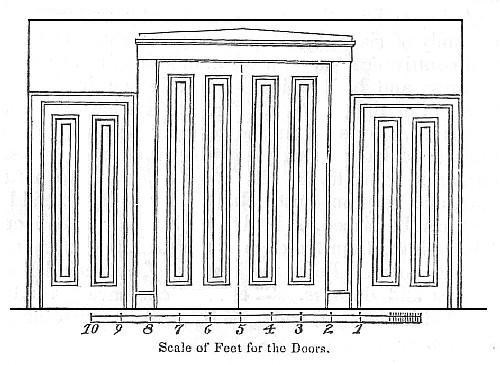
The two large doors, in the centre, open into the bedpress, and one of the smaller ones into the closet, f. The other, can either be a false door, in order to secure symmetry, or else a real one, opening into the kitchen, j.
A room, thus arranged, can be made to serve as a genteel parlor, for company, during the day, when all these doors can be closed. At night, the doors of the bedpress being opened, it is changed to an airy bedroom, while the closets, f, f, serve to conceal all accommodations pertaining to a bedroom. The bedpress is just large enough to receive a bed; and under it, if need be, might be placed a trucklebed, for young children. The eating-room, c, has the small bedroom, d, adjoining it, which, by leaving the door open, at night, will be sufficiently airy for a sleeping-room. The kitchen, j, has a smaller bedroom, d, attached to it, which will hold a narrow single bed for a domestic; and, if need be, a narrow trucklebed under it, for a child. The staircase to the garret, can either be placed in the eating-room, or in the small entry. A plan for back accommodations is shown in Fig. 35, (page 276.) These should be placed in the rear of the kitchen, so as not to cover the window.
A house like this, will conveniently accommodate a family of six or eight persons; but some economy and contrivance will be needed, in storing away articles of dress and bedclothing. For this end, in the bedpress, k, of the parlor, b, (Fig. 18,) a wide shelf may be placed, two feet from the ceiling, where winter bedding, or folded clothing, can be stowed, while a short curtain in front, hung from the wall, will give a tidy look, and keep out dust. Under this shelf, if need be, pegs can be placed, to hold other articles; and a curtain be hung from the edge of the shelf, to conceal and protect them. Both the closets, f, f, should have shelves and drawers. The garret can have a window inserted in the roof, and thus be made serviceable for storage.
Fig. 20.
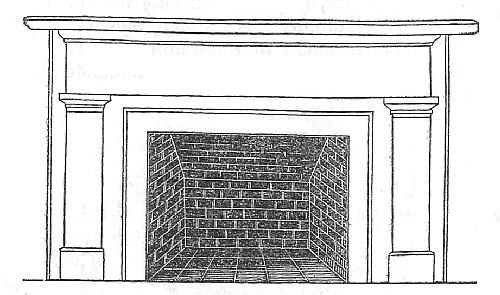
Figure 20 represents a fireplace and mantelpiece, in a style corresponding with the doors.
Such a cottage as this, could be built for from five hundred to nine hundred dollars, according as the expense of labor in the place, and the excellence of the materials and labor, may vary.
Fig. 21.

Figures 21 and 22, show the elevation and ground-plan of a cottage, in which the rooms are rather more agreeably arranged, than in the former plan. The elevation, (Fig. 21,) has a piazza, running across the whole front. This would cost nearly two hundred dollars; and, for this sum, another story might be added. An architect told the writer, that he could build the two-story house, (Fig. 23 and 24,) without a piazza, for the same sum, as this cottage, with one. This shows the poor economy of these appendages.
The ground-plan, (Fig. 22,) will be understood, from the explanation appended to it.
Fig. 22.

Scale of Feet.
a, Porch.
b, Entry.
c, Stairs.
d, Parlor, 16 by 20 feet.
e, Dining-room, 16 by 16 feet.
f, Kitchen.
g, g, g, Bedpresses.
h, h, h, h, Closets.
i, Store-closet.
j, Back entry and Sink.
p, Cellar stairs.
o, o, o, Fireplaces.
The parlor, d, is designed to have the doors (shown in Fig. 19) placed at the end, where is the bedpress, g. This will make it a handsome parlor, by day, and yet allow it to be used as a bedroom, at night. The bedpresses, in the other rooms, can have less expensive doors. A window is put in each bedpress, to secure proper ventilation. These should be opened, to air the bed, on leaving it. These can be fitted up with shelves, pegs, and curtains, as before described. If the elevation of the first cottage be preferred to this, as being less expensive, it can be used, by altering it a little; thus, instead of the projection for the entry, make a slight projection, of the width of one brick, to preserve the same general outside appearance. Let the windows extend down to the floor, and the beauty of symmetry will also be preserved.
Fig. 23.
Ground-plan.

Scale of Feet.
a, Entry.
b, Stairs.
c, Parlor, 16 by 20 feet.
d, Kitchen, 14 by 14 feet.
e, Store-closet.
f, Pantry.
g, Sinkroom.
h, Closet.
i, i, Fireplaces.
n, Cellar door.
o, Oven.
y, Furnace.
z, Sink.
Fig. 24.
Second Story.

a, Stairs.
b, Passage.
c, c, c, Bedrooms.
d, d, d, d, Closets.
e, e, Fireplaces.
f, Nursery.
g, Room for young children.
The plans, shown in Fig. 23 and 24, are designed for families, where most domestic labor is to be done without the aid of domestics. The parlor, c, is for a sitting-room, and for company. The room, d, is the eating-room; where, also, the ironing and other nicer family work can be done. In the small room, g, either an oven and boiler, or a cooking-stove, can be placed. The elevation, shown in Fig. 25, is designed for the front of this house.
Fig. 25.
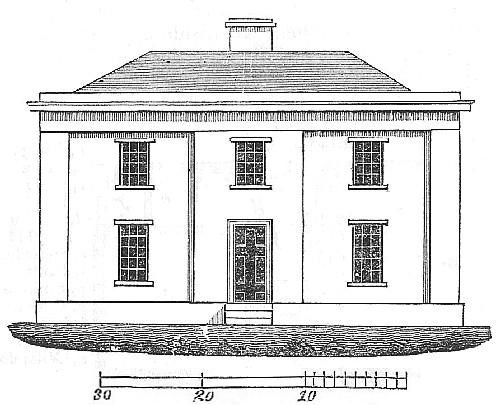
Fig. 26.
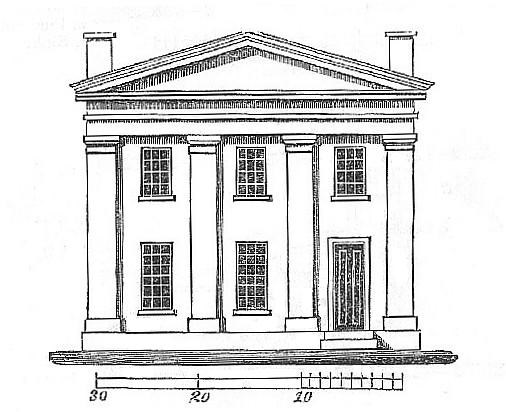
Figures 27 and 28, are plans of a two-story house, on a larger scale, with a concealed staircase, for front and back use. The elevation, Fig. 26, is designed for this plan.
Fig. 27.
Ground-plan.

b, b, Entry.
c, Stairs.
d, Parlor, 16 by 20 feet.
e, Dining-room, 15 by 16 feet.
f, Kitchen, 15 by 16 feet.
g, g, g, Closets.
h, Store-closet.
i, Back entry.
j, Pantry.
k, k, k, Fireplaces.
x, Cellar stairs.
Fig. 28.
Second Story.

a, a, a, a, Bedrooms.
b, Stairs.
c, c, c, Closets.
d, Passage.
e, e, e, Fireplaces.
y, Garret stairs.
Fig. 29.
Ground-floor.

b, Entry.
c, Parlor, 17 by 17 feet.
d, Dining-room, 13 by 15 feet.
e, Parlor or Bedroom,
17 by 17 feet.
f, Kitchen, 19 by 17 feet.
g, Stairs.
h, Store-closet.
i, i, i, Closets.
n, n, n, n, Fireplaces.
o, Folding-doors.
p, Pegs for over-garments.
z, Cellar stairs.
Fig. 30.
Second Story.

a, a, a, a, a, Bedrooms.
b, Stairs.
c, Passage.
d, d, d, d, Closets.
e, e, e, e, Fireplaces.
Figures 29 and 30, are plans for a larger house, which can have either of the elevations, Fig. 25 or 26, adapted to it. These also have a concealed staircase, for front and back use. If a nursery, or bedroom, is wished, on the ground-floor, the back parlor, e, can be taken; in which case, the closets, i, i, are very useful. To prevent noise from reaching the front parlor, two sets of folding-doors, each side of the passage, o, could be placed. With this arrangement, these rooms could be used, sometimes as two parlors, opening into each other, by folding doors, and at other times, as a nursery and parlor. In this plan, the storeroom, h, and china-closet, i, between the kitchen and eating-room, are a great convenience.
Figures 31 and 32, present the plan of a Gothic cottage, which secures the most economy of labor and expense, with the greatest amount of convenience and comfort, which the writer has ever seen.
Fig. 31.
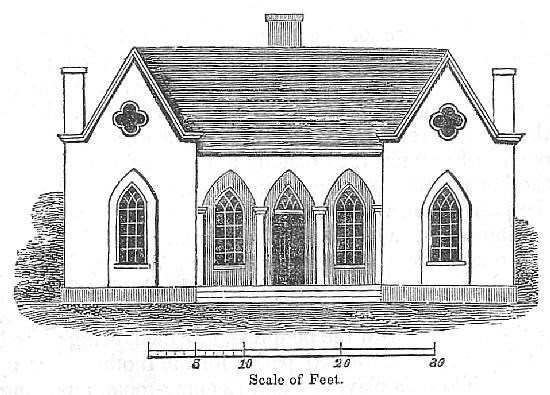
The elevation, (Fig. 31,) exhibits the front view. It has a recess in the central part, under which, is the door, with a window on each side of it. This forms a piazza; and into this, and a similar one at the back of the house, the two centre parlors open.
Fig. 32.
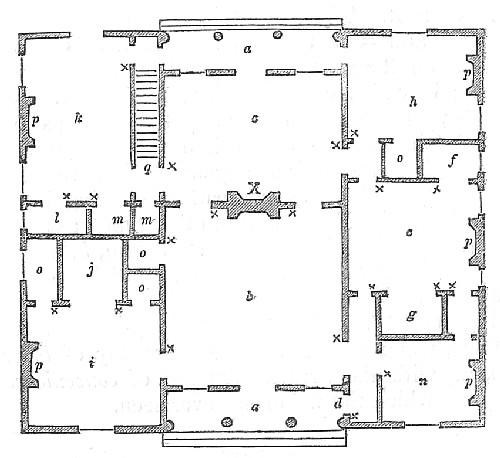
In the centre of the house, (see Fig. 32,) are the two parlors, b and c; the back one to be used as an eating-room. At X, can be placed, either a chimney, with doors on each side of the fireplace, or, (which is the most agreeable,) folding-doors, which can be thrown open in Summer, thus making a large saloon, through the house, from one piazza to the other. In this case, the parlors are warmed by a large stove, set near the folding-doors, which would easily warm both parlors and one or two adjacent rooms. In Winter, the outside doors, opening to the piazzas, should be fastened and calked, and the side entry, at d, be used. At e, is the nursery, with the bedpress, g, which, being closed by day, makes a retired parlor for the mother. At n, is the children's playroom and sleeping-room, adjoining the mother's room. At k, is the kitchen, adjacent to the eating-room, with the storeroom, e, and the closets, m, m, one for the eating-room, and one for the kitchen utensils. At i, is a parlor, which can be used for a study or library, by the master of the family; while the adjacent bedpress, j, renders it a convenient lodging-room, for guests. Another lodging-room, is at h; and in the attic, is space enough for several comfortable lodging-rooms. A window in the roof, on the front and back, like the one on Wadsworth's Cottage, (Fig. 33,) could be placed over the front door, to light the chambers in the attic. A double roof in the attic, with a current of air between, secures cool chambers. The closets are marked o, and the fireplaces p. The stairs to the attic are at q. By this arrangement, the housekeeper has her parlor, sleeping-room, nursery, and kitchen, on the same floor, while the rooms with bedpresses, enable her to increase either parlors or lodging-rooms, at pleasure, without involving the care of a very large and expensive house.



